Fire is a constant threat, and understanding fire safety regulations is a necessity across the globe. While fundamental principles remain consistent, each country has its own unique approach to fire prevention and protection.
Whether you’re a homeowner, a business operator, or simply curious about safety standards around the world, exploring fire safety regulations across different countries will reveal the diverse ways we protect our lives and property. Let’s embark on a journey to understand the complexities of international fire safety regulations.
Fire Safety Regulations In United States
Fire safety in the United States is governed by a combination of federal, state, and local regulations. The Occupational Safety and Health Administration (OSHA) plays a significant role in setting and enforcing fire safety standards across various sectors, including general industry, maritime, construction, and agriculture. Here are some key points regarding fire safety regulations in the U.S.:
Regulatory Bodies
- OSHA (Occupational Safety and Health Administration): OSHA enforces workplace safety standards, including fire prevention and protection in workplaces across the US. (https://www.osha.gov/fire-safety)
- NFPA (National Fire Protection Association): The NFPA develops a widely used set of fire and life safety codes and standards. These codes, while not legally binding, are often adopted into law by states, cities, and local jurisdictions. (https://www.nfpa.org)
- State and Local Fire Marshals: Each state and many localities have fire marshals or similar offices responsible for enforcing fire codes, conducting inspections, and investigating fires.
Key NFPA Standards Related to Fire Safety
- NFPA 1: Fire Code: A comprehensive code addressing fire prevention, suppression, building construction, and means of egress.
- NFPA 10: Portable Fire Extinguishers: Guidelines for the selection, placement, inspection, and maintenance of fire extinguishers.
- NFPA 13: Automatic Sprinkler Systems: Standards for sprinkler system design, installation, and maintenance.
- NFPA 70: National Electrical Code (NEC): Electrical safety standards to minimize the risk of electrical fires.
- NFPA 101: Life Safety Code: Focuses on building design and features that protect occupants from fire, such as exit routes, fire alarms, and emergency lighting.
Common Fire Safety Regulations
- Emergency Action Plans: Businesses must have plans outlining procedures for evacuation, fire reporting, and employee training.
- Fire Prevention Plans: Plans for minimizing fire hazards, such as proper storage of flammable materials and regular housekeeping.
- Means of Egress: Requirements for adequate exits, including their number, capacity, and accessibility.
- Fire Alarm and Suppression Systems: Requirements for the installation and maintenance of fire alarms, sprinklers, and other suppression systems in various occupancies.
- Fire Extinguisher Requirements The type, placement, and maintenance of portable fire extinguishers.
- Electrical Safety: Adherence to the NEC to prevent electrical fires.
- Hazardous Materials: Regulations for the safe storage and handling of flammable, combustible, explosive, and other hazardous materials.
Important Notes
- Local variations: Fire codes can vary significantly between states, counties, and cities. It’s essential to check the specific regulations that apply to your location.
- Workplace vs. Residential: Fire safety regulations may differ for workplaces compared to residential buildings.
- Regular Updates: Fire codes and regulations are constantly updated to reflect the latest advancements in fire safety technology and practices.
For Additional Information
- OSHA website: https://www.osha.gov/fire-safety
- NFPA Website: https://www.nfpa.org
- Your local Fire Marshal’s office
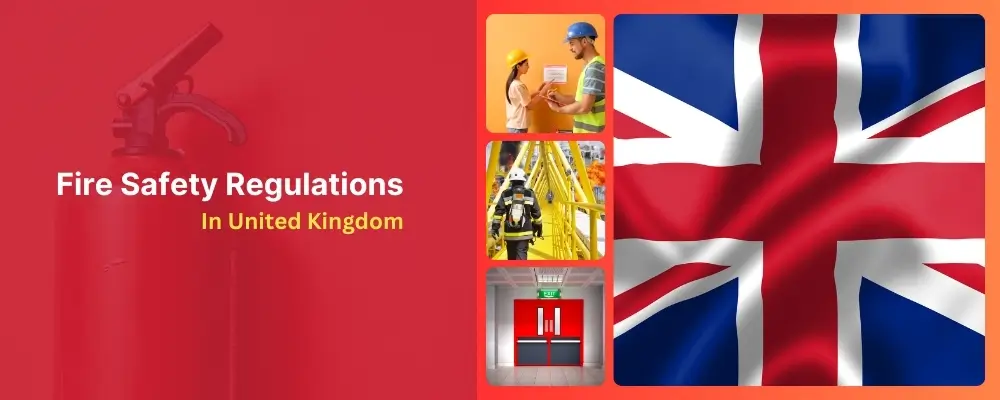
Fire Safety Regulations In United Kingdom
In the United Kingdom, fire safety regulations are primarily governed by the Regulatory Reform (Fire Safety) Order 2005 (FSO) for England and Wales, which applies to all workplaces and the common parts of buildings containing two or more domestic premises. The FSO places legal duties on the “Responsible Person” (usually the owner or landlord) to undertake and record a fire risk assessment and to put in place and maintain general fire precautions.
Primary Legislation
- The Regulatory Reform (Fire Safety) Order 2005 (FSO): The central piece of fire safety legislation in England and Wales. It places the responsibility for fire safety on the “Responsible Person” of a premises (e.g., building owner, employer, landlord).
- Fire and Rescue Services Act 2004: Provides the framework for fire and rescue services, including duties around fire prevention and responding to fires.
- Fire Safety Act 2021: Introduced following the Grenfell Tower tragedy, this act amends the FSO, clarifying responsibilities for external walls and flat entrance doors in high-rise residential buildings.
- Fire Safety (England) Regulations 2022: Further details specific requirements and obligations under the amended Fire Safety Order, especially for high-rise residential buildings.
Key Regulatory Concepts
- Fire Risk Assessments: The Responsible Person must conduct a thorough fire risk assessment to identify hazards, potential risks, and implement appropriate fire safety measures.
- General Fire Precautions: A wide range of measures to prevent fires, manage them if they happen, and ensure safe evacuation, including:
Specific Requirements for High-Rise Residential Buildings
Due to the heightened risk and the Grenfell Tower tragedy, high-rise residential buildings (over 18 meters high) have additional requirements under the Fire Safety (England) Regulations 2022:
- Regular checks of flat entrance doors and common part fire doors
- Provision of building floor plans and plans for external walls to the Fire and Rescue Service
- Installation of wayfinding signage for firefighters
- Regular inspections of lifts and other firefighting equipment
- Providing fire safety information to residents
Important Resources
- GOV.UK: The official UK government website has comprehensive guidance on fire safety regulations: https://www.gov.uk/government/collections/fire-safety-guidance
- National Fire Chiefs Council (NFCC): Provides additional guidance and resources for fire safety professionals: https://www.nationalfirechiefs.org.uk
- Local Fire and Rescue Services: Your local service can offer advice tailored to your specific building or circumstances.
Notes
- Scotland and Northern Ireland: These regions have slightly different fire safety legislation. Check their respective government websites for details.
- The “Responsible Person”: This varies depending on the building type. In residential buildings, it could be the building owner, landlord, or a managing agent. In workplaces, it’s typically the employer.
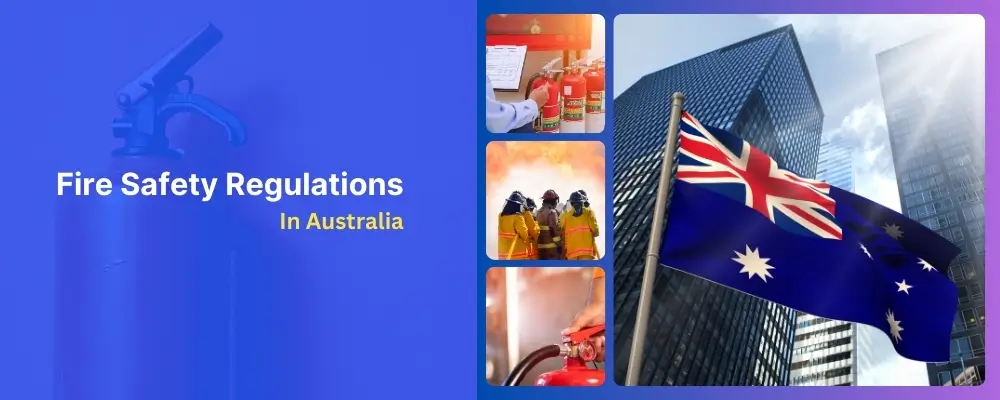
Fire Safety Regulations In Australia
In Australia, fire safety regulations and standards are designed to prevent fire hazards and ensure the safety of buildings and their occupants. These regulations are living standards that consistently change at both the state and national levels. It’s important for businesses and building owners to comply with the legislation relevant to the time of their building’s approval, as well as any changes that occur to the premises.
Key Australian Fire Safety Standards:
- AS 1670: Automatic fire detection and alarm systems
- AS 1841: Portable fire extinguishers
- AS 1851: Routine service of fire protection systems and equipment
- AS 2293: Emergency escape lighting and exit signs
- AS 2444: Portable fire extinguisher and fire blankets
- Building Codes of Australia/National Construction Codes (BCA/NCC)
- Mines Safety Inspection Act and Regulations 1994
- Occupational Safety and Health Regulations 1996 (WA)
State-Specific Regulations:
Each Australian state and territory has its own set of standards and regulations, making it crucial for businesses to be aware of and comply with the specific requirements applicable to their location.
Compliance and Enforcement:
FCF Fire & Electrical has developed resources to help businesses understand their fire safety responsibilities. Engaging an expert is recommended to ensure that your building and business meet the correct fire legislation and to stay updated with any changes in the regulations.
For detailed information on fire safety regulations applicable to your specific state or territory, or for assistance with compliance, it’s advisable to consult with fire safety professionals or visit the official fire regulations website at fireregulations.com.au.
This approach ensures that all state guidelines are followed, allowing building owners to rest assured that they are adhering to all applicable laws and protecting their property and occupants effectively.
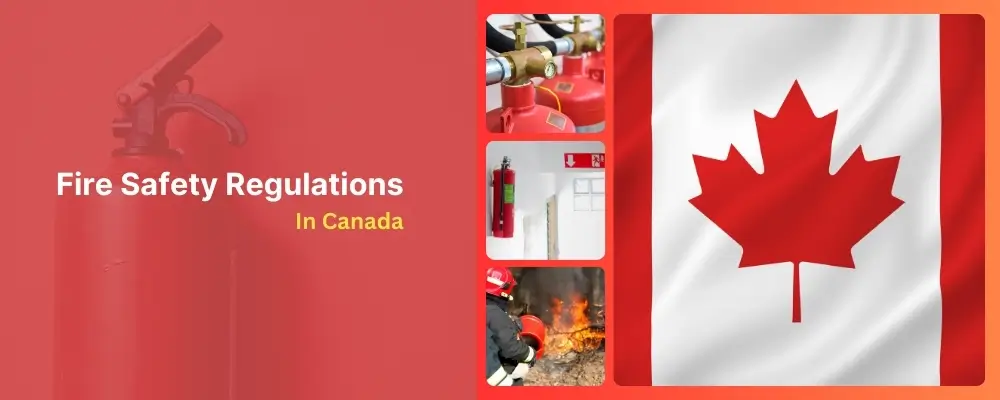
Fire Safety Regulations In Canada
Here’s a breakdown of fire safety regulations in Canada. It’s important to note that fire safety is regulated at multiple levels in Canada, leading to some variations between provinces, territories, and municipalities.
Key Regulatory Framework
- National Fire Code of Canada (NFC): This comprehensive code sets out technical fire safety requirements for building design, construction, and maintenance. The NFC is developed by the Canadian Commission on Building and Fire Codes but is not legally binding in itself.
- Provincial and Territorial Legislation: Each province and territory has laws that adopt the NFC either in full or with modifications. They also have fire safety acts and regulations that outline the responsibilities of fire services, building owners, and occupants.
- National Building Code of Canada (NBC): The NBC incorporates fire safety provisions from the NFC, making some requirements mandatory for new construction.
- Municipal Bylaws: Cities and towns can have their own fire safety bylaws to address specific local needs or risks.
Important Regulatory Bodies
- Provincial/Territorial Fire Marshals or Fire Commissioners: Responsible for overarching fire safety regulation, code enforcement, investigations, and public education in their jurisdiction.
- Local Fire Services: Enforce fire codes within their municipality, conduct inspections, issue permits, and provide fire safety education.
- Canadian Commission on Building and Fire Codes (CCBFC): Develops and maintains the National Fire Code and National Building Code.
Key Fire Safety Requirements
- Fire Prevention Plans: Businesses and many buildings may need to develop fire prevention plans that detail fire hazards, safety measures, and inspection procedures.
- Fire Alarm and Suppression Systems: Installation and maintenance of fire alarms, sprinklers, and other suppression systems in accordance with building type and occupancy.
- Emergency Exits and Evacuation: Adequate design, number, and maintenance of emergency exits, along with evacuation plans and drills.
- Fire Extinguishers: Provision of portable fire extinguishers in appropriate types, numbers, and locations.
- Fire Drills: Regular fire drills for occupants of many workplaces and buildings.
- Hazardous Materials: Safe storage, handling, and disposal of flammable, combustible, explosive, or other hazardous materials.
For More Information
- Provincial/Territorial Fire Marshal or Fire Commissioner websites: Search for your specific province or territory to find their fire safety legislation and guidance.
- National Fire Code of Canada (free online): https://nrc.canada.ca/en/certifications-evaluations-standards/codes-canada/codes-canada-publications/national-fire-code-canada-2020
- Your Local Fire Department: They can provide advice on the specific regulations applicable to your building and situation.

Fire Safety Regulations In Germany
Germany has a highly developed and structured approach to fire safety, with regulations present at multiple levels.
Key Regulatory Framework
- Musterbauordnung (MBO): The Model Building Code is a set of guidelines that form the basis for fire safety regulations in each German state. Individual states have their own building codes (Landesbauordnungen) that closely adhere to the MBO.
- Sonderbauverordnungen: Special Building Regulations apply to specific types of buildings with high occupancy or unique risks (e.g., schools, hospitals, assembly halls).
- DIN Standards: The German Institute for Standardization provides a wide range of technical standards (DIN) relevant to fire safety equipment, systems, and procedures.
- Technical Rules for Workplaces (ASR): These rules detail fire safety requirements within workplaces.
- State Fire Services: Each state has its fire service (Feuerwehr) responsible for enforcing fire safety regulations and conducting inspections.
- German Institute for Construction Technology (DIBt): This institute provides approvals and certifications for fire protection products and systems.
Key Fire Safety Regulations
- Fire Resistance Classes: Building materials and components are classified according to their fire resistance, helping ensure adequate structural integrity in a fire.
- Fire Compartments: Buildings are divided into fire compartments to limit the spread of fire and smoke.
- Escape Routes: Detailed requirements for the number, width, and design of escape routes based on building occupancy.
- Fire Detection and Alarm Systems: Installation and maintenance of fire alarms and smoke detectors.
- Fire Doors and Smoke Control Systems Regulations govern self-closing fire doors and smoke ventilation systems.
- Fire Extinguishers: Requirements for the type, number, and placement of fire extinguishers.
- Fire Safety Plans: Businesses and buildings must have fire safety plans, including evacuation procedures and staff training.
Important Resources
- German Institute for Construction Technology (DIBt): https://www.dibt.de/ (Look for information on “Brandschutz” – fire protection)
- Individual State Building Codes (Landesbauordnungen): You will need to find the specific code for your state.
- Association for the Promotion of German Fire Protection (vfdb): https://www.vfdb.de
- Your Local Fire Service (Feuerwehr): Can provide guidance on local requirements.
Things to Note
- Language: Most regulations are in German. You might need translation assistance if you don’t speak the language.
- Regional Variations: While regulations are broadly similar across states, there can be subtle differences in details or enforcement approaches.
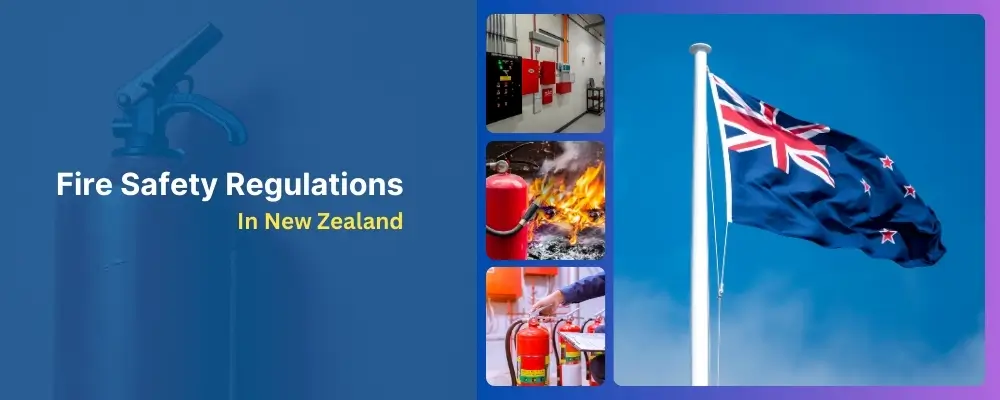
Fire Safety Regulations In New Zealand
Fire safety regulations in New Zealand are comprehensive and aim to ensure the safety of individuals and property from fire hazards. These regulations cover a wide range of areas including building construction, fire alarm systems, escape routes, and emergency lighting, and are enforced through various pieces of legislation and guidelines. Key aspects of New Zealand’s fire safety regulations include:
Primary Legislation
- Fire and Emergency New Zealand Act 2017 (FENZ Act): The key piece of legislation governing fire safety. It establishes Fire and Emergency New Zealand as the primary firefighting and rescue service and gives it responsibilities in fire prevention and building compliance.
- Building Act 2004: Sets out building performance requirements, including fire safety provisions.
- Building Code: Part of the Building Act, it specifies detailed technical requirements for building design and construction to achieve fire safety objectives.
Important Regulatory Bodies
- Fire and Emergency New Zealand (FENZ): Plays a critical role in fire safety through inspection, enforcement, education, and providing guidance on regulations (https://fireandemergency.nz/)
- Ministry of Business, Innovation & Employment (MBIE): Responsible for the overall building regulatory system, including the Building Act and Building Code. (https://www.building.govt.nz/)
Key Concepts and Requirements
- Means of Escape: Buildings must have adequate and maintained escape routes in case of fire.
- Fire-resistance Ratings (FRRs): Building elements are assigned FRRs based on how long they can withstand fire, ensuring structural stability during evacuation and firefighting.
- Fire Cells and Smoke Compartments: Buildings are divided into fire cells or compartments to limit the spread of fire and smoke.
- Fire Alarm and Suppression Systems: Requirements for the installation and maintenance of fire alarms, sprinklers (in certain buildings), and other suppression systems.
- Fire Extinguisher and Hose Reels: Provision of appropriate types and numbers of extinguishers and hose reels.
- Evacuation Schemes: Many buildings require approved evacuation schemes that detail procedures and responsibilities during a fire emergency.
- Hazardous Substances: Regulations for the safe storage and handling of flammable, explosive, or other hazardous materials.
Specific Requirements for High-Risk Buildings
- Specified Systems: Buildings with complex fire protection systems or significant hazards require “specified systems”. These systems must be designed, installed, and maintained by qualified professionals.
- Building Warrant of Fitness (BWOF): Owners of many buildings must obtain and maintain a BWOF, which includes annual inspections and certification of fire safety systems.
Resources
Important Notes
- Always refer to the primary legislation for the most up-to-date and complete regulations.
- Specific requirements can vary depending on the building type and occupancy.
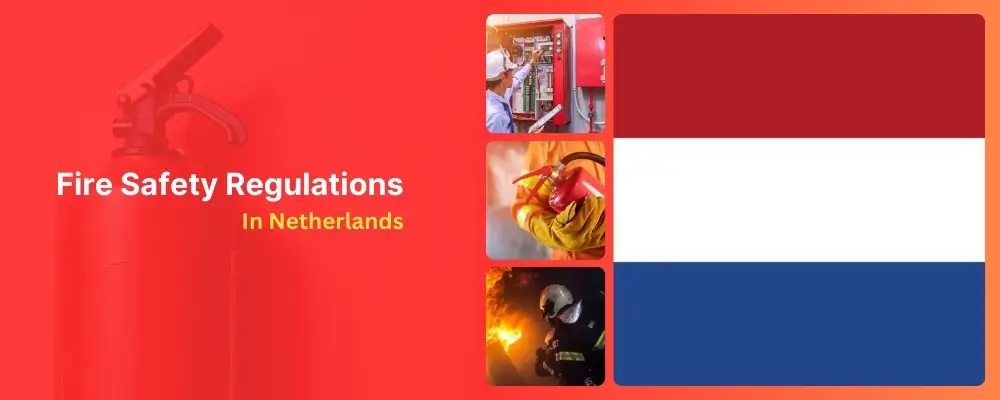
Fire Safety Regulations In Netherlands
Fire safety regulations in the Netherlands are designed to ensure the safety of individuals and property from fire hazards. These regulations are comprehensive and encompass various aspects of building design, construction, and maintenance, as well as the management of fire safety measures within buildings. Key elements of the Dutch fire safety regulations include:
Key Regulatory Framework
- Building Decree 2012 (Bouwbesluit 2012): The central legal document containing technical requirements for building construction, including fire safety provisions.
- Fire Safety Usage Decree (Gebruiksbesluit): Supplements the Building Decree with specific regulations on fire safety during building usage.
- Environmental Management Act (Wet milieubeheer): Provides broader framework for managing environmental risks, including fire safety aspects.
- Municipal Regulations: Local municipalities can sometimes have additional fire safety bylaws or regulations.
Important Regulatory Bodies
- Ministry of the Interior and Kingdom Relations: Responsible for overall fire safety policy and legislation.
- Local Fire Services (Brandweer): Enforce fire safety regulations, conduct inspections, issue permits (if needed), and provide advice to building owners.
- Netherlands Institute for Physical Safety (IFV): Provides knowledge, data, and guidance on fire safety. (https://nipv.nl/)
Key Fire Safety Requirements
- Fire Compartments: Buildings are divided into fire compartments to limit the spread of fire and smoke.
- Escape Routes: Detailed requirements for the design, capacity, and maintenance of escape routes.
- Fire Detection and Alarm Systems: Installation and maintenance of fire alarms and smoke detectors.
- Firefighting Equipment: Provision of fire extinguishers, hose reels, and other suppression systems as required.
- Risk Assessments: In many cases, a fire risk assessment is required to identify potential hazards and implement appropriate fire safety measures.
- Fire Safety Plans: Businesses and organizations may need to develop and maintain fire safety plans.
- Permits: In some cases, businesses or buildings with higher fire risks might require special permits from the local fire service.
Resources
- Dutch Government Website (Rijksoverheid): Provides information on building regulations (https://www.rijksoverheid.nl/onderwerpen/bouwregelgeving)
- Netherlands Institute for Physical Safety (IFV): https://nipv.nl/
- Your Local Fire Service (Brandweer): Can provide information on the specific regulations for your area and building type.
Important Notes
- Language: Many regulations and resources are primarily in Dutch. You might need translation assistance if you don’t speak the language.
- Building and Occupancy Types: Specific fire safety requirements can vary depending on the type of building (residential, commercial, industrial) and its occupancy.
Conclusion
Staying informed about fire safety regulations – both in your own country and globally – isn’t just about compliance; it’s about safeguarding lives and minimizing the devastating impact of fires. By comparing different approaches, we can identify best practices and constantly strive to improve our fire safety standards. Remember, preparedness and awareness are our greatest weapons against the unpredictable nature of fire.

